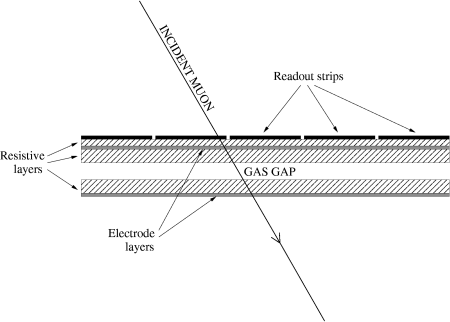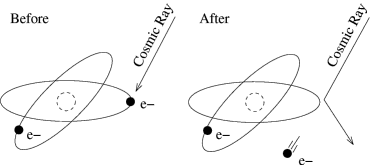An affordable particle detector for education
This project entailed developing a device to measure particles from outer space which bombard the Earth constantly. These particle are collectively called cosmic rays. This device eventually is to be used in in colleges and schools for A-Level standard education (ages 16-18).
Papers
- Interim Report: November 2004 (.pdf)
- Final report: May 2005 (.pdf >7MB!)
- Errata for final report (.pdf)
Cosmic Rays
We are constantly being bombarded by radiation from outer space. Most of this radiation takes the form of particles travelling at near light speeds whose exact origin is still debated. These particles are known as cosmic rays.
Smaller cosmic ray particles such as neutrinos pass down through the atmosphere, avoiding all the air molecules. These are notoriously hard to detect since they also tend to pass right through detectors! Larger particles smash into molecules high in the atmosphere creating a cascade of smaller particles in the event. It is these 'debris' particles that we hope to detect.
Resistive Plate Chambers
A relatively new (~20 years) type of cosmic ray detector is the Resistive Plate Chamber (RPC). We chose to investigate adapting RPCs for use in classrooms since they are relatively cheap to build and versatile.
An RPC consists of two plates of highly resistive material seperated by a gap of around 2mm. The two outer surfaces of these plates are coated with a conductor. A high voltage is applied, (5kV or more,) with the anode at the conducting surface of one plate, the cathode at the conducting surface of the other.

The idea is that when a particle passes through the gas gap from above, it ionises the gas along the path it travelled. The electrons and positive ions in this region are attracted towards the anode and cathode respectively. A spark forms from this flow of charge and is earthed through the electrodes. We can measure this earthed current directly although we risk damaging sensitive readout electronics due to the unpredictable spark. To avoid this we lay strips of metal (the readout strips) above the electrode, insulated by a resistive layer. The earthed current in the main electrode induces a current in the readout strips which is what we measure.
In order to generate a nice clear signal and lots of detectible charge through ionisation we fill the gap between the plates with a special mix of gases. Generally this includes Argon, Freon and iso-Butane although lots of mixtures are possible. We hope to investigate mixtures that are Environmentally friendly and non-flammable.
Notes
Radiation
Generally, any particle (tiny bit of matter) moving fast enough can be termed as radiation. This also includes 'particles' of pure energy such as photons which do not actually have any mass but move at the speed of light. Equations such as Einstein's E=mc2 which basically say a lot of energy = a bit of mass, have blurred the boundaries between particles with mass and energy.
Not all radiation is harmful, light for example is a form of radiation. How harmful radiation is depends on how penetrating it is, i.e. how easily it passes through your skin and how ionising it is. Light is neither.
Although some cosmic rays are both penetrating and ionising, the amount of cosmic rays that pass through you on the earth's surface is relatively low. Any damage done is easily compensated for by the body's immune system.
Ionisation
Sometimes an atom (an arrangement of protons, neutrons and electrons) with zero overall charge has an electron freed from one of its 'orbits'. This can happen when a highly energetic particle such as a cosmic ray collides with it. The result is two particles, one negatively charged electron and one positively charged atom known as an ion. This process is known as ionisation.

Electric Charge
Some particles have electric charge, it is either positive or negative. Oppositly charged particles attract, similar charged particles repel. Movement or flow of charge is called current and is what powers our fridges etc.
Most current is due to a flow of particles called electrons, the smallest independant charged particle.
Anodes and Cathodes
An anode is an electrode with a concentration of positive charge, a cathode is an electrode with a concentration of negative charge.
An electrode can be any conducting material such as a piece of metal.
Inductance
A current (a flow of charge) generates a magnetic field. If this current is changing (i.e. from weak to strong) it will generate a current in a conductor which lies within this magnetic field.

In general, this current is weaker the further the conductor is away from the original current.
See also ...
- An experiment in an online lab-book. Abandoned since I could not write notes when at home
- Some python code written to model the system and predict some other factors
